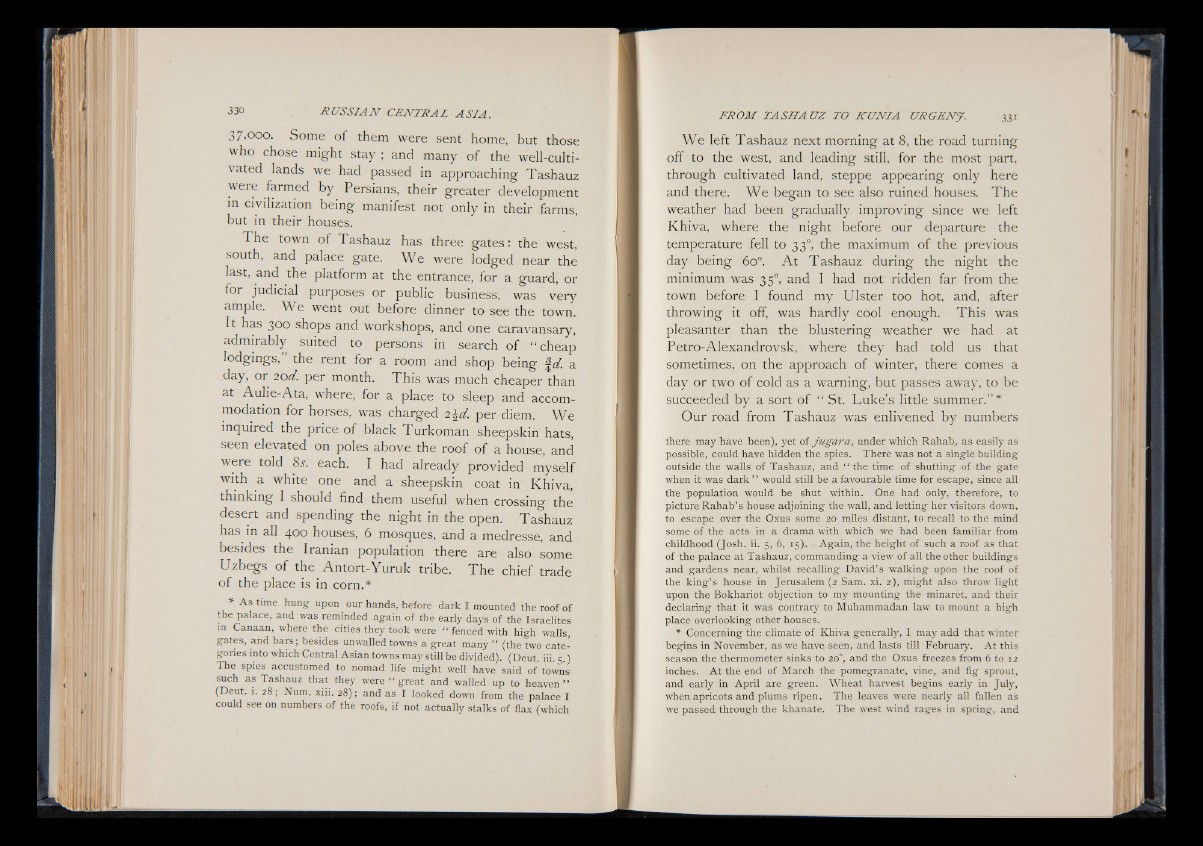
37,000. Some o f them were sent home, but those
who chose might stay ; and many of the well-cultivated
lands we had passed in approaching Tashauz
were farmed by Persians, their greater development
in civilization being manifest not only in their farms,
but in their houses.
T he town o f Tashauz has three gates: the west,
south, and palace gate. W e were lodged near the
last, and the platform at the entrance, for a guard, or
for judicial purposes or public business, was very
ample. W e went out before dinner to see the town.
It has 300 shops and workshops, and one caravansary,
admirably suited to persons in search of “ cheap
lodgings,” the rent for a room and shop being f d. a
day, or 20d. per month. This was much cheaper than
at Aulie-Ata, where, for a place to sleep and accommodation
for horses, was charged 2\d . per diem. We
inquired the price o f black Turkoman sheepskin hats,
seen elevated on poles above the roof of a house, and
were told 8s. each. I had already provided mysèlf
with a white one and a sheepskin coat in Khiva,
thinking I should find them useful when crossing the
desert and spending the night in the open. Tashauz
has in all 400 houses, 6 mosques, and a medresse, and
besides the Iranian population there are also some
Uzbegs of the Antort-Yuruk tribe. The chief trade
of the place is in corn.*
* As time hung- upon our hands, before dark I mounted the roof of
the palace, and was reminded again of the early days of the Israelites
in Canaan, where the cities they took were “ fenced with high walls,
gates, and bars; besides unwalled towns a great many ” (the two categories
into which Central Asian towns may still be divided). (Deut. iii. 5. )
The spies accustomed to nomad life might well have said of towns
such as Tashauz that they were “ great and walled up to heaven ”
(Deut. i. 28 ; Num. xiii. 28) ; and as I looked down from the palace I
could see on numbers of the roofs, if not actually stalks of flax (which
We left Tashauz next morning at 8, the road turning
off to the west, and leading still, for the most part,
through cultivated land, steppe appearing only here
and there. We began to see also ruined houses. The
weather had been gradually improving since we left
Khiva, where the night before our departure the
temperature fell to 330, the maximum of the previous
day being 6o°. A t Tashauz during the night the
minimum was 350, and I had not ridden far from the
town before I found my Ulster too hot, and, after
throwing it off, was hardly cool enough. This was
pleasanter than the blustering weather we had at
Petro-Alexandrovsk, where they had told us that
sometimes, on the approach of winter, there comes a
day or two of cold as a warning, but passes away, to be
succeeded by a sort of “ St. Luke’s little summer.” *
Our road from Tashauz was enlivened by numbers
there may have been), yet of jugara, under which Rahab, as easily as
possible, could have hidden the spies. There was not a single building
outside the walls of Tashauz, and “ the time of shutting of the gate
when it was dark ” would still be a favourable time for escape, since all
the population would be shut within. One had only, therefore, to
picture Rahab’ s house adjoining the wall, and letting her visitors down,
to escape over the Oxus some 20 miles distant, to recall to the mind
some of the acts in a drama with which we had been familiar from
childhood (Josh. ii. 5, 6, 13). . Again, the height of such a roof as that
of the palace at Tashauz, commanding a view of all the other buildings
and gardens near, whilst recalling David’ s walking upon the roof of
the king’ s house in Jerusalem (2 Sam. xi. 2), might also throw light
upon the Bokhariot objection to my mounting the minaret, and their
declaring that it was contrary to Muhammadan law to mount a high
place overlooking other houses.
* Concerning the climate of Khiva generally, I may add that winter
begins in November, as we have seen, and lasts till February. At this
season the thermometer sinks to 20°, and the Oxus freezes from 6 to 12
inches. At the end of March the pomegranate, vine, and fig sprout,
and early in April are green. Wheat harvest begins early in July,
when apricots and plums ripen. The leaves were nearly all fallen as
we passed through the khanate. The west wind rages in spring, and